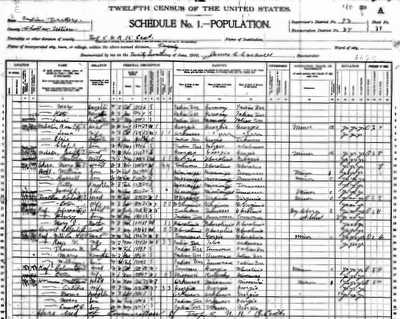 |
| Cora Lee Bell |
Cora Lee
Bell was born on 13 August 1896 in Indian Territory, the daughter of Thomas
Jefferson and Cornelia (Roberts) Bell.
She was listed on the 1900 census in Township 2 South, Range 5 East,
Chickasaw Nation, Indian Territory, with her father shown as Jefferson Bell,
age 27, born in Mississippi, and her mother as Cornelia, age 35, born in
Tennessee. Her parents stated they had
been married 7 years. Cora was 3, and
her siblings were Clara E., age 5, and James A., age 1.
 |
| 1900 Indian Territory Census Thomas Jefferson Bell & family |
In 1910 the
Bells were living in Johnson County, Texas, probably in the home of Thomas’s
Aunt Lydia Powell Ray, who was living with her sister Bennie in Briscoe County,
Texas. Cora is 13, James is 11, and another sister has been born—Cornelia M.,
age 6. Living in the same household is
sister Clara E., age 15, and her husband, John A. (Angus) Guest, and their son,
Stanley (transcribed as Uriel E.), age 8 months.
 |
| 1910 Johnson County, TX Census Thomas Jefferson Bell & family |
On 28
January 1917 Cora Bell, age 20, who resided in Dustin, Oklahoma, married John
W. Wheat, age 37, in Carson, Hughes County, Oklahoma. In September 1918 they were living in
Oklahoma City, according to John’s World War I draft registration. In 1920 the Wheats were living back in Dustin
with their first child, Leona, age 2.
Son William Powell was born in 1920, followed by daughter Iona Marie in
1922 and daughter Ida Belle in 1925.
John Wheat died in 1927 and on the 1930 census Cora and her children are
living with her father, Thomas J. Bell, in Dustin.
 |
| Bell-Wheat marriage license |
Cora married
Henry Paul Alstatt, a widower, on 18 June 1938 in Dustin. On the 1940 census the blended family
included Henry’s children Bonnie, Jack, and Betty Joe, and Cora’s children,
Powell, Marie, and Ida Belle.
 |
| Granny and Henry |
Cora Altstatt
was Granny to me, and Henry was Papa Henry.
My dad and paternal grandparents took my brother and me to Dustin to see
Granny often when we were kids. I think
my grandmother Smith must have felt she had something to prove to Granny about
how she was taking care of us; I remember that within a few miles of Dustin,
Tim and I climbed in the back seat and changed clothes so we’d be fresh and
presentable when we got to Granny’s house. Dustin was so different than our
home in Tulsa. Granny had a big garden,
and raised hogs and chickens, and we walked a dirt road down to visit Aunt
Clara.
 |
| My two grandmothers and me |
 |
| Aunt Clara and Granny in Granny's front yard |
Granny was a
good cook and a wonderful seamstress, and she was scared to death of storms. I can’t say that I know much more about her;
for one, of course, we didn’t live with her, but for another, she was very
quiet and always seemed unhappy to me. Even before Henry’s death in 1970,
Granny went to a nursing home in Wetumka where she was basically unresponsive
for years before she died in 1981. Later,
when I was old enough to understand, I wondered if losing her two girls, Leona
and my mother, so young, was just too much for her to bear. Now that I know more about her mother, I also
think she must have had a difficult childhood, and she probably had a difficult
marriage with John Wheat. I found this
picture of her recently and realized, among all the other photos I have of her,
this is the only one in which she is smiling.
 |
| Granny and me |




























